International Journal of Aquaculture and Fishery Sciences
Effects of Afrostyrax lepidophyllus fruit bean powder in feed as a growth activator on the zootechnical performance of Oreochromis sp (red Tilapia) fry in concrete tanks
Ngouana Tadjong Ruben1*, Yemdji Mane Divine Doriane1, Dadjodi Erra Amandine2, Ebile Dayan Agwah2, Kana Jean Raphaël2 and Téguia Alexis2
2Faculty of Agronomy and Agricultural Sciences, Department of Animal Science, Laboratory of Animal Nutrition, University of Dschang, Dschang, Cameroon
Cite this as
Ruben NT, Divine Doriane YM, Amandine DE, Agwah ED, Raphaël KJ, et al. (2023) Effects of Afrostyrax lepidophyllus fruit bean powder in feed as a growth activator on the zootechnical performance of Oreochromis sp (red Tilapia) fry in concrete tanks. Int J Aquac Fish Sci 9(3): 022-028. DOI: 10.17352/2455-8400.000088Copyright License
© 2023 Ruben NT, et al. This is an open-access article distributed under the terms of the Creative Commons Attribution License, which permits unrestricted use, distribution, and reproduction in any medium, provided the original author and source are credited.This study focused on the effect of feed supplementation with Afrostyrax lepidophyllus fruit bean powder on some zootechnical performances of Oreochromis sp (red tilapia) fry in concrete tanks. 360 monosex fry of Oreochromis sp with an average weight of 1.95 ± 0.34g were divided into 12 happas, including 30 subjects per happa in triplicate in a completely randomized system for four food rations. TS (Imported Skreting feed), T0 (feed without supplement), T(0.1%F) (feed containing 0.1% A. lepidophyllus fruit bean powder), T(0.2%F) (food containing 0.2% fruit bean powder of A. lepidophyllus).
These feeds were distributed 4 times a day to the fry at a regular time interval of 3 hours including 7 a.m., 10 a.m., 1 p.m. and 4 p.m. the fry were fed at 11% of their biomass for one month and then at 10% for six weeks. The analysis of variance showed no significant difference (p > 0.05) in the survival rates (97.66 ± 1.02%-98.66 ± 0.90%) but a trend on the rise in favor of feeds supplemented with the spice. Live weight (19.37 ± 0.47), average weight gain (16.96 ± 0.47), total length (7.80 ± 0.04), daily weight gain (0.22 ± 0.01g/d), the specific growth rate (9.12 ± 0.25g%/d) were significantly higher (p < 0.05) with fry fed with feed supplemented at 0.2 % fruit beans of A. lepidophyllus (T0.2%F) compared to the fry fed with the feed without supplement (T0) but significantly (p < 0.05) lower compared to the values recorded with the fry fed with the feed imported feed Skreting (TS). The feed conversion ration was not significantly (p > 0.05) affected regardless of the treatment considered. Total length was significantly (p < 0.05) higher with fish fed imported feed (TS) and feed supplemented with 0.2% A. lepidophyllus fruit bean powder compared to treatments. Fed with feed without supplement (T0) and with feed supplemented with 0.1% of this spice (T0.1%F). The significantly higher feed cost of production (p < 0.05) was recorded with the treatment fed imported feed Skreting (TS) compared to the other treatments which were also comparable to each other for this parameter. The condition factor K was not significantly (p > 0.05) affected by the treatments. The supplementation of 0.2% of A. lepidophyllus bean powder in the feed can advantageously be used to improve the zootechnical performance of Oreochromis sp fry in the pre-fattening phase.
Introduction
One of the challenges of the present century is that of solving the problem of food insecurity, which is a growing problem, hence the mission of the FAO, which is to fight hunger and poverty in the world. In view of the increase in the world population, which is around 10 billion people, and people suffering from hunger, undernourishment or malnutrition have increased since 2015 [1]. Achieving food self-sufficiency therefore represents a major challenge for developing countries, in this case those in Africa. Thus, the first Millennium Development Goal (MDG1) is to solve the problem of poverty and guarantee food security in the world [2]. The growing need for quantity and quality of dietary protein requires special attention to be paid to fish production, given that fish and other aquatic products are recognized as both the healthiest foodstuffs on the planet and whose influence on the natural environment is very small [1]. In Cameroon, fish is the main source of animal protein, a very valuable source of essential trace elements for nutritional balance and health. The decline in catches observed today is attributable to the increase in fishing intensity, the pollution of aquatic environments, the destruction of fish habitats, the introduction of new species and climate change [3]. According to Junie, et al. [4]. Absence of fish feed industries, difficult access to credit, absence and/or lack of quality fingerlings, lack of qualified personnel, lack of mastery of production technologies and poor management of fish ponds are all constraints that continue to hamper the development of the sub-sector in Cameroon. However, rich in its biodiversity in terms of resources, it has significant production potential. Natural resources can therefore be exploited directly or indirectly in fish production. Despite the various efforts made by the Cameroonian government to intensify the aquaculture sector, feeding fish species remains a major difficulty faced by fish farmers. Since the ban on the use of antibiotics as growth promoters in animal feed in the European Union in 2006, we have witnessed the emergence on the market of many natural feed additives which have the potential to improve animal production performance. Among these additives can be mentioned probiotics, prebiotics, trace elements, enzymes, plant extracts, essential oils (HE) and spices. Spices are noble products that used in small quantities alone or in mixtures improve the flavor of the feeds in which they are incorporated. Some also have nutritional virtues, functional properties and pharmacological virtues [5]. Some spices commonly used in the preparation of traditional dishes in Africa have been the subject of numerous chemical studies [5-7]. For example, Tetrapleura tetraptera known in Cameroon under the name of “4 sides” is a spice widely used in traditional sauces whose chemical composition reveals substances such as saponin, flavonoids and alkaloids which gives it an activity antibacterial [6] and anti-ulcer [8]. Furthermore, the study by Nweze, et al. [7] revealed that its use as an additive in broiler drinking water improves its growth performance, blood constituents, balances the intestinal bacterial flora and reduces the cost of production. Afrostyrax lepidophyllus is also a local spice consisting of 91% sulphide-containing compounds and 1.2% phenylpropanoid (eugenol) which has a strong inhibitory effect on the growth of human cancer cells [9]. The aqueous extracts of this spice have anti-amylase and anti-lipase activity which give it antioxidant potential [10]. Furthermore, Moukette, et al. [11] reported that the extracts of Afrostyrax lepidophyllus have a high content of polyphenolic and flavonoid compounds, exhibiting a strong antioxidant potential and a significant protective potential on liver enzymes, an ability to reduce the population of pathogenic bacteria in the intestine, thus reducing the competition they deliver to the intestinal flora beneficial for the occupation of the intestinal walls and therefore ensuring the good health of the digestive tract for better absorption of nutrients. Bark and fruits of Afrostyrax lepidophyllus commonly called washer or wild onion is a spice whose functions are to stimulate the functions of pancreatic enzymes (lipases, amylases and proteases) and increase the activity of digestive enzymes in the stomach and gastric mucous membranes [12,13]. According to Muneendra, et al. [14], The bark and fruit of this spice Afrostyrax lepidophyllus contain compounds possessing significant antioxidant properties with many other attributes including stimulation of digestive enzymes, lipid metabolism and modulation of microbial populations. However, this spice has not yet been studied in aquaculture feed. Tilapia, being one of the species of piscicultural interest prized by the population, and whose breeding requires a food as well as ecological and biological contribution meeting its requirements in order to intensify its production. It is in this perspective that this study was initiated with the general objective of contributing to the search for antibiotic substitutes that can promote animal growth and are safe for humans and the environment.
Materials and methods
Study zone
The study was carried out at the Agro-ecological farm in the village called Bilone located in Cameroon, in the Center Region, Department of Lékié, Arrondissement of Obala with geographical coordinates 4° 10’ 00’’ of latitude North and 11° 32’ 00’’-11°31’60’’ East longitude and 539-528 m above sea level. The average precipitation per year is around 1577 mm. Temperatures reach maximums of 35 °C in the dry season and 20°C in the rainy season [15].
Biological material
360 monosex red tilapia fingerlings, with an average weight of 1.95 ± 0.34g and a total length of 2.4 ± 0.15 cm were used in this study. These fingerlings were purchased from the YOULIA FISH farm based in Douala-Cameroon. The fry were acclimatized for two weeks in the happas in a concrete tank and fed with a feed formulated with local ingredients during this period.
An exogenous skreting brand food whose composition is given by the manufacturer was purchased in the local market.
The various ingredients used for the formulation of the other three rations and the bark of Afrostyrax lepidophyllus were purchased on the local market in the city of Yaoundé, Central Region of Cameroon.
Non-biological material and experimental device
12 happas with a mesh diameter of 0.2 mm and a dimension of 0.4×0.4×1 m, sewn beforehand and installed in a 15 m3 concrete tank following a completely randomized device (3 repetitions x 4 treatments) were used. Each replicate contained 30 fry and each treatment 90 fry.
Experimental rations
Four isoprotein feeds of 42% have been formulated. A positive control ration without supplement consisting of imported feed skreting T0+, a negative control ration consisting of feed formulated with local ingredients without supplement T0-. From the latter, two other rations were formulated by adding 0.1% fruit bean powder of A. lepidophyllus (T0.1%F), and 0.2% fruit bean powder of A. lepidophyllus (T0.2%F). The various ingredients used for the formulation of its feeds were purchased on the local market and distributed according to the proportions previously established and given in Table 1. The ingredients were measured, mixed by hand, granulated with a granulator and then dried in the oven. Open air on a tarp.
Rations
Ts = Skreting brand feed (Positive control);
T0 = Local feed without supplement (Negative control);
T0.1% F = Feed supplemented with 0.1% Afrostyrax lepidophyllus fruit bean powder;
T0.2% F = Feed supplemented with 0.2% Afrostyrax lepidophyllus fruit bean powder.
Conduct of the trial
Each treatment thus contained a total of 90 fingerlings, therefore 3 happas of 30 fingerlings each. These fry were fed at a frequency of four times (4) per day at a regular interval of 3 hours including 7 a.m., 10 a.m., 1 p.m. and 4 p.m. with quantities of food equivalent to 11% of their biomass during the first month then 10 % over 6 weeks of experience for all treatments. A control fishing was carried out every two weeks (after 14 days) and at the end of its fishing the characteristics of growth such as the weight was measured using a balance sensitivity of 0.001g to the load. Then with an SF-400 scale with a sensitivity of 1g, the size (total length) of the fry was measured using graph paper. The fry were introduced into a bucket containing water and were handled in such a way as not to leave them out of the water for long. Before distribution of the different diets, the quantities proportional to the densities of the fry for each happa were calculated, weighed and crumbled. These quantities of feed distributed to the fry were adjusted according to their evolution. A TDS/EC/PH/SALT/SG/ORP brand multi-parameter was used for taking the temperature and the JBL brand analysis kit for taking the physicochemical parameters.
Zootechnical parameters and characteristics studied
➣ Survival rate (SR)
SR (en%) = 100 × NF/Ni
NF = number of fish at the end of the experiment and Ni = number of fish at the start of the experiment.
Growth characteristics
➣ Live weight
At the start of the test and every 14 days thereafter, fish from each experimental unit were weighed. The weekly weight gain was obtained by taking the difference between 2 consecutive average weekly live weights
➣ Average weight gain (AWG in g) = final average fish weight (FAFW in g) - initial average fish weight (IAWG in g);
➣ Average daily gain (ADG in g/day) = (FAWG-IAWG)/t With IAW = initial average weight (g), FAW = final average weight (g), t = duration of the experiment (in days);
➣ Specific growth rate (SGR in %day) = [(ln Pmf –ln Pmi)/ rearing time (day)] x 100; Pmi = initial average weight (g), Pmf = final average weight (g);
➣ Feed conversion ratio (FCR) = Quantity of feed distributed / Body mass gain;
➣ Condition factor (K) = W×100/ LT3 with W: weight (g), LT: Total length (cm).
➣ Cost of feed intake = cost of kg of feed x feed intake;
➣ Feed cost of production of one kg of fish (FPC in CFA francs) = Purchase price of the feed × CI
Statistical analyzes
Data on survival rate, growth and economic characteristics were subjected to one-way analysis of variance (ANOVA 1). When significant differences existed between the treatment means, Duncan’s test was applied to separate at the 5% significance level. SPSS 20.0 (Statistical Package for Social Sciences) statistical software was used for these analyses.
Results and discussions
Effect of feed supplemented with Afrostyrax lepidophyllus fruit bean powder on the survival rate in the pre-fattening phase of Oreochromis sp fry.
The effects of feeds supplemented with Afrostyrax lepidophyllus fruit bean powder. On the survival rate of fry of Oreochromis sp are represented in Figure 1. It appears that whatever the treatment considered, the supplementation of the food with the fruit bean powder of A. lepidophyllus had no no significant effect (p > 0.05) on the survival rate of fry of Oreochromis sp. However, there is an upward trend when Afrostyrax lepidophyllus fruit bean powder. Is supplemented in the feed. The highest survival rate (p > 0.05) was recorded with the diet supplemented with 0.2% A. lepidophyllus fruit bean powder (98.66 ± 0.90%) and the rate the lowest (p > 0.05) with Ts positive feeds (97.66 ± 1.02%).
The survival rate, which varied from 97.66 ± 1.02% to 98.66 ± 0.90%, was not significantly (p > 0.05) affected by the treatments over the entire period. His results are superior to those of Togoli, et al. [16] who recorded varying survival rates of 88.67 ± 1.53% to 95.00 ± 1.00% on Oreochromis niloticus with food supplemented with 10, 20 and 30 grams of Garcinia kola and Turraea heterophylla. On the other hand, this survival rate is less than 100% recorded by Gültepe, et al. [17] with a feed supplemented with 0, 200, 400 and 600mg/kg feed of Tribulus terrestris extracts on the growth of Oreochromis niloticus fry. The plant extracts and concentrations tested did not negatively influence fry survival rates. Similar conclusions were made by Pechsiri and Yakupitiyage [18]. Similarly, the survival rates noted would indicate that these fry value the feed supplemented with fruit bean powder from A. lepidophyllus without affecting their survival. The difference observed compared to Togoli, et al. [16] could be explained by the 0.2% level of fruit bean powder of A. lepidophyllus in food which would have biochemical properties to strengthen the immune system thus improving the resistance of fish to diseases and the stress of breeding.
Effect of feed supplemented with A. lepidophyllus fruit bean powder in the feed on some growth performance of Oreochromis sp. fry.
The growth characteristics of Oreochromis sp fry over the entire trial period are grouped in Table 2 and illustrated in Figures 1-5.
It shows that apart from feed consumption, the consumption index and the condition factor, all the other characteristics increase significantly (p < 0.05) increased with the supplementation of feed with bean powder. Of fruits of A. lepidophyllus.
Feed intake
Mean feed consumption (Table 2) was not significantly (p > 0.05) affected by feed supplementation with A. lepidophyllus fruit bean powder. However, the highest feed consumption (104.86 ± 3.52g) was recorded with the fry fed imported feed skreting (TS) and the lowest (491.40 ± 16.42g) (p > 0 0.05) with the fry fed with the feed supplemented with 0.1% fruit bean powder of A. lepidophyllus (T0.1%F).
Live weight, weight gain, specific growth rate
From Table 2, it appears that live weight, weight gain and specific growth rate were significantly higher (p < 0.05) with the fry fed with imported feed skreting Ts (21.97 ± 1.53g; 19.55 ± 0.25g and 9.81 ± 0.22 g%/d respectively) compared to all other rations. However, with supplementation with A. lepidophyllus fruit bean powder, the 0.2% T(0.2%F) supplement feed made it possible to record significantly (p < 0.05) higher performance. (19.37 ± 0.47g; 16.96g ± 0.47; 9.81 ± 0.22 respectively) compared to fingerlings fed local feed without supplement T0 (17.10 ± 0.58g; 14.69 ± 0.40g; 6.99 ± 0.51g%/d respectively) which also recorded the lowest performance and to fry fed with feed supplemented with 0.1% fruit bean powder from A. lepidophyllus T(0.1%F) (17.93 ± 0.55g; 15.52 ± 0.55g; 7.08 ± 0.25g%/day respectively).
The bi-weekly live weight curves (Figure 2) of the different treatments show the same profile, the same pace and the same trend. However, from the beginning to the end of the study, the curve of the fry fed with the imported feed remained well above those of the other treatments over the entire period of the study.
The variations in weight gain and specific growth rate of fry from the different treatments over the entire period of the study illustrated in Figures 3,4 show an increase in weight gain and specific growth rate with increasing rates. Of A. lepidophyllus fruit bean powder in the diet compared to the control ration without supplement. However, at the rate of 0.2% A. lepidophyllus fruit bean powder, a significantly higher weight gain and specific growth rate (p < 0.05) were recorded compared to the treatments without supplement (T0) and T(1%F).
This study demonstrates that the presence of Afrostyrax lepidophyllus fruit bean powder has a positive effect on the well-being and growth of fish. The growth factors in this case the average weight gain (14.69 ± 0.40g to 19.55 ± 0.25g), the daily weight gain (0.20 ± 0.01g/d to 0.28 ± 0.01g/d), the specific growth rate (6.99 ± 0.51g%/d to 9.81 ± 0.22g%/d) observed during the experiment varied significantly (p < 0. 05) with the treatments. They were higher with the skreting diet, followed by those of the diet supplemented with 0.2% Afrostyrax lepidophyllus fruit bean powder, compared to those of the other treatments. But these recorded weight gain values are lower than those of Touahria [19] who obtained weight gains of 23.8 g and 21.8 and a daily weight gain of 0.39 g/d and 0 .35g/d over a period of 60 days using foods made from agricultural by-products (soybean meal, cottonseed cake, corn and millet bran) and commercial food. Similarly, the average weights and weight gain recorded in this work are higher than those of Gültepe, et al. [17] who found that different concentrations of Maltese cross T. terrestris (200, 400 and 600 mg/kg) in diets improved the growth performance of O. niloticus by 304.04 ± 0.16 % at 446.35 ± 1.03%. Similar results were observed in Poecilia reticulata [20] and Cryptoheros nigrofasciatus [21] which were fed diets containing extracts of Maltese cross T. terrestris. Moreover, various studies have revealed that plant extracts improve the growth of aquatic animals [22-24].Although our results indicate that A. lepidophyllus fruit bean powder has growth-stimulating effects in fish, there are gaps in understanding the mechanisms of action of these extracts in fish. Unknown factors in various medicinal plants lead to favorable results in fish and shrimp trials [25]. Medicinal plants promote lipid metabolism, protein accumulation and growth performance [22]. The fruit bean powder of A. lepidophyllus commonly known as wild onion is a spice whose functions are to stimulate the functions of pancreatic enzymes (lipases, amylases and proteases) and increase the activity of digestive enzymes in the stomach and gastric mucous membranes [12,13]. Moukette, et al. [11] reported that the bark and bean extracts of Afrostyrax lepidophyllus fruits have a high content of polyphenolic and flavonoid compounds, exhibiting strong antioxidant potential and significant protective potential on liver enzymes. Furthermore according to [9] the bark and fruit beans of Afrostyrax lepidophyllus contain compounds possessing important antioxidant properties with many other attributes including stimulation of digestive enzymes, lipid metabolism and modulation of microbial populations.
The Feed conversion ratio
The analysis of variance showed no significant difference (p > 0.05) in the Feed conversion ratio between the treatments over the entire study period. However, the conversion ration varies between 5.36 ± 0.56 and 5.90 ± 0.10.
At the end of this experiment, no significant difference was observed between the treatments (p > 0.05) but the consumption indices obtained varied between 5.36 and 5.90. These values of the consumption index are higher compared to those obtained by Bamba, et al. [26] which was 1.5 and 2.5. From its values obtained it could be that the fry consume the food more than they grow. But a question about the effective intake of its food is inevitable given these high values. This could also be due to losses by dispersion of the food in the water at distribution.
The condition factor K
The conditioning factor K was not significantly (p > 0.05) affected by the treatments over the entire study period. However, it varied between 1.51 ± 0.66 and 1.79 ± 0.03%.
The curves of the biweekly evolution of the condition factor of fry fed with food supplemented with A. lepidophyllus fruit bean powder as a function of time show the same profile and evolve in sawtooth.
The condition factor K during the period of the experiment did not have a significant difference (p > 0.05). These values varied between 1.51 and 1.70%. These values of the condition factor K obtained at the end of the test were lower than 2.53 and 2.36 reported by Tigoli, et al. [16] for 30 days by incorporating respectively 20% Garcinia kola and 10% Turraea heterophylla in O. niloticus and comparable to those obtained by Ibrahim, et al. [27] on O. niloticus fry which are around 1.04 ± 0.02; 1.79 ± 0.05; 1.98 ± 0.1 respectively high in open water, Enclosure and Happas for males and less than 1.99 ± 0.05; 2.76 ± 0.02a; 2.44 ± 0.04 for females obtained by the same author. This difference could be explained by exogenous factors such as the composition of the experimental feed, the farming infrastructure, and endogenous factors, namely the size and strain of the fish, which were different.
Feed cost of production
The feed cost of production was significantly (p < 0.05) higher with the subjects fed the imported feed skreting TS (153.72 ± 7.20 fcfa) compared to the local ration without supplement T0 (51.66 ± 6.65 fcfa) and rations supplemented with grain powder of A. lepidophyllus T(0.1%F) and T(0.2%F) (53.97 ± 8.68 and 56.70 ± 2 20 CFA francs respectively) which were also comparable to each other.
Feed production costs were significantly (p < 0.05) affected. That of the imported feed is significantly higher compared to those of the other treatments which were comparable between them, testifying that the supplementation of feed with the powder of fruit beans of A. lepidophyllus induces a reduction in the cost of production.
Conclusion
At the end of this study on the effect of the supplementation of the fruit bean powder of Afrostyrax lepidophyllus in the feed on some zootechnical performances of the fry of Oreochromis sp (red tilapia) in concrete tank, it appears that the rate survival, growth characteristics and feed cost of production were significantly and positively affected by the level of A. lepidophyllus fruit bean powder supplementation. However, the highest zootechnical parameters were recorded in subjects fed feed supplemented with 0.2% A. lepidophyllus fruit bean powder.
In addition, these test feeds have varying consumption indexes, although statistically not different; when these are lower than that of the commercial industrial feed on the market. The feeds developed in this study have the advantage of being locally available, relatively less expensive, and accessible to fish farmers, unlike commercial industrial feed. Utilization of locally available feed ingredients would reduce the cost of compounded feeds and feed preparation can be done on a small scale leading to job creation in the field.
Recommendations
Subject to additional studies, producers can advantageously use the feed formulated from local products and supplemented with 0.2% powdered Afrostyrax lepidophyllus fruit beans for feeding Oreochromis sp fry in the pre-fattening phase.
Contributions of authors
Dr Ngouana Tadjong Ruben Lecturer, Department of Aquaculture, Institute of Fisheries Sciences university of Douala was the supervisor of this work, led the data analysis and writing of the manuscript, Dr YEMDJI MANE Divine Doriane, Dr DAYAN AGWAH Ebile revised the manuscript and DADJODI ERRA Amandine the conduct of the trial and data collection.
- FAO (2020) The State of World Fisheries and Aquaculture 2020. Sustainability in action. 1-212. https://doi.org/10.4060/ca9229fr.
- FAO (2018) The global situation of fisheries and aquaculture; Achieve sustainable development goals. 1-254.
- FAO (2015) Climate change, the roles of genetic resources for food and agriculture. Rome, Italy.
- Junie AA, Christian D, Jean-Claude M. Fish farming in Cameroon: assessment and prospects. 2019. http://indexmedicus.afro.who.int.
- Tchiégang C, Mbougueng PD. Chemical composition of spices used in the preparation of Nah pohet from Nkui of western Cameroon. Tropicultura. 2005; 23(4) : 193-200.
- Uchechi NE, Chigozie FO. Antibacterial activity of tetrapleura tetraptera taub.pod extracts. International Journal of Pharmacology and Biological Sciences. 2010; 1(4): 734-741.
- Nweze BO, Nawankwagu AE. Effets of Tetrapleura under different feeding regimes on growth performance and gut microbes of broiler chicken. Proc.35th Conf.Nig. Soc. Ainm. Prod. 14-17 March, Univ. Of Ibadna, Nigeria. 2011; 299.
- Noamesi BK, Mensah JF, Bogale M, Dagne E, Adotey J. Antiulcerative properties and acute toxicity profile of some African medicinal plant extracts. J Ethnopharmacol. 1994 Mar;42(1):13-8. doi: 10.1016/0378-8741(94)90017-5. PMID: 8046938.
- Fogang HP, Maggi F, Tapondjou LA, Womeni HM, Papa F, Quassinti L, Bramucci M, Vitali LA, Petrelli D, Lupidi G, Vittori S, Barboni L. In vitro biological activities of seed essential oils from the Cameroonian spices Afrostyrax lepidophyllus MILDBR. and Scorodophloeus zenkeri HARMS rich in sulfur-containing compounds. Chem Biodivers. 2014 Jan;11(1):161-9. doi: 10.1002/cbdv.201300237. PMID: 24443436.
- Oben J, Etoundi CB, Kuaté D, Ngondi JL. Anti-amylase, anti-lipase and antioxidant effects of aqueous extracts of some Cameroonian spices. Journal of Natural Products. 2010 ; 3:165-171.
- Moukette M, Constant AP, Prosper CNB, Vicky JAM, Eustace B, Jeanne YN. Afrostyrax lepidophyllus extracts exhibit in vitro free radical scavenging, antioxidant potential and protective properties against liver enzymes ion mediated oxidative damage. BMC Research Notes. 2015; 8:344:1-12.
- Frankič T, Voljc M, Salobir J, Rezar V. Use of herbs and spices and their extracts in animal nutrition. Acta agriculture Slovenica. 2009; 94:95-102
- James N, Murithi B, Muwonge H, Sembajwe LF, Kateregga J. Antidiarrheal activity of ethanolic fruit extract of Psidium guayava (Guava) in castor oil induced diarrhea in albino rats. Natl J Physiol Pharm Pharmacol. 2013; 3: 191-197.
- Muneendra K, Vinod K, Debashis R, Raju K, Shalini V. Application of Herbal Feed Additives in Animal Nutrition - A Review. Int J Livest Research. 2014; 4: 1-8.
- PCD-OBALA (2013) Obala municipal development plan. 16.
- Tigoli K. Effects of two African aphrodisiac plants Garcinia kola and Turraea heterophylla on zootechnical performance and the rate of sexual inversion in Oreochromis niloticus. Environment and Aquatic Biology Laboratory (LEBA), Nangui Abrogoua University, Abidjan. 2020; 12.
- Gültepe N, Acar Ü, Kesbiç OS, Yýlmaz S, Yýldýrým Ö, Türker A. Effects of Dietary Tribulus terrestris Extract Supplementation on Growth, Feed Utilization, Hematological, Immunological, and Biochemical Variables of Nile Tilapia Oreochromis niloticus. Isr J Aquacult Bamidgeh. 2014; 66: 1-8.
- Pechsiri J, Yakupitiyage A. A comparative study of growth and feed utilization efficency of sex reversed diploid and triploid Nile tilapia, Oreochromis niloticus. Aquacult. Res. 2005; 36: 45-51.
- Touahria N. Effect of feed type on some red tilapia production parameters in the Biskra region. 2020.
- Çek F, Turan F, Atik E. Masculinization of convict cichlid (Cichlasoma nigrofasciatum) by immersion in Tribulus terrestris extract. Aquac Int. 2007;15 (2): 109-119.
- Cek S, Turan F, Atik E. The effects of Gokshura, Tribulus terrestris on sex reversal of guppy, Poecilia reticulata. Pak J Biol Sci. 2007 Mar 1;10(5):718-25. doi: 10.3923/pjbs.2007.718.725. PMID: 19069853.
- Sivaram V, Babu MM, Citarasu T, Immanuel G, Murugadass S, Marian MP. Growth and Immune response of juvenile greasy groupers (Epinephelus tauvina) fed with herbal antibacterial active principle supplemented diets against Vibrio harveyi infections. Aquaculture. 2004; 237(4): 9 - 20.
- Kaleeswaran B, Ilavenil S, Ravikumar S. Dietary supplementation with Cynodon dactylon (L.) Enhance innate immunity and disease resistance of Indian major carp, Catlacatla (Ham). J Vet Anim Adv. 2011; 10 (4): 511-517.
- Prasad G, Mukthiraj S. Effect of Methanolic extract of Andrographis paniculata (Nees) on growth and haematology of Oreochromis mossambicus (Peters). World J Fish Marine Sci. 3 (6): 473 - 479.
- Fallahpour F, Banaee M, Javadzade N. Effects of dietary marshmallow (Althaea officinalis L.) extract on growth performance and body composition of common carp (Cyprinus carpio). Int J Adv Biol Biom Res. 2014; 2(8): 2453 - 2460.
- Bamba Y, Ouattara A, Kouassi S, Da costa & Gourène G. Production of Oreochromis niloticus with agricultural by-product feeds. Sciences & Nature. 2008 ; 5 : 89–99.
- Ibrahim IOE, Rodrigue P, Roland TN, Léa GT, Prudencio A. Biometric indices and growth parameters of tilapia Oreochromis niloticus (Linnaeus,1758) exposed to agricultural pesticides in water reservoirs in North Benin. Int J Biol Chem Sci. 2018; 12(3): 1401-1414.
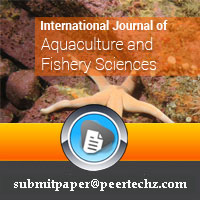
Article Alerts
Subscribe to our articles alerts and stay tuned.
 This work is licensed under a Creative Commons Attribution 4.0 International License.
This work is licensed under a Creative Commons Attribution 4.0 International License.
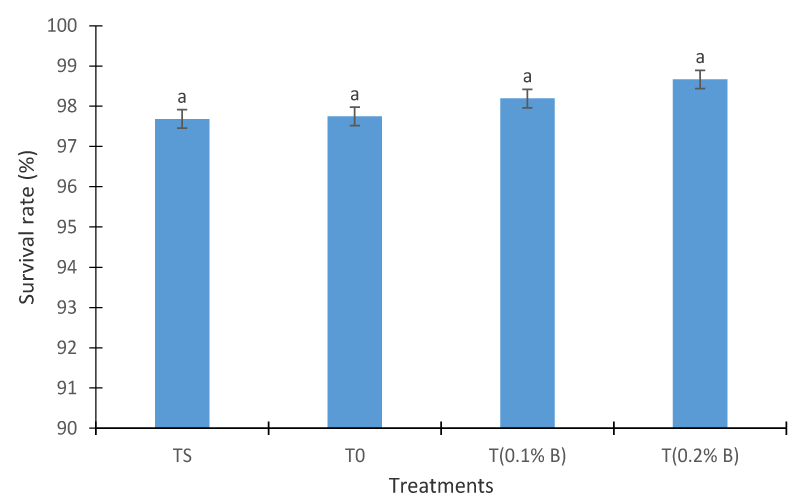
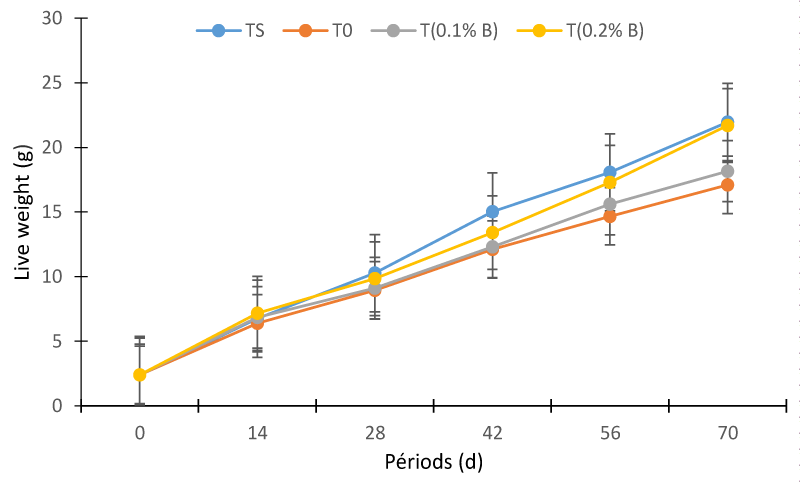
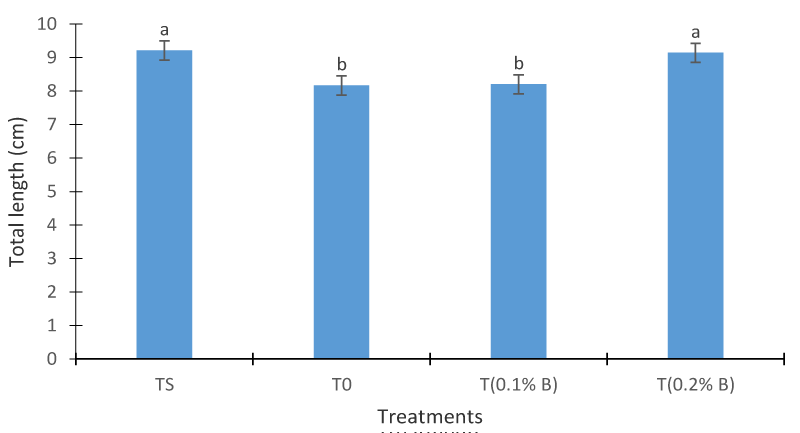
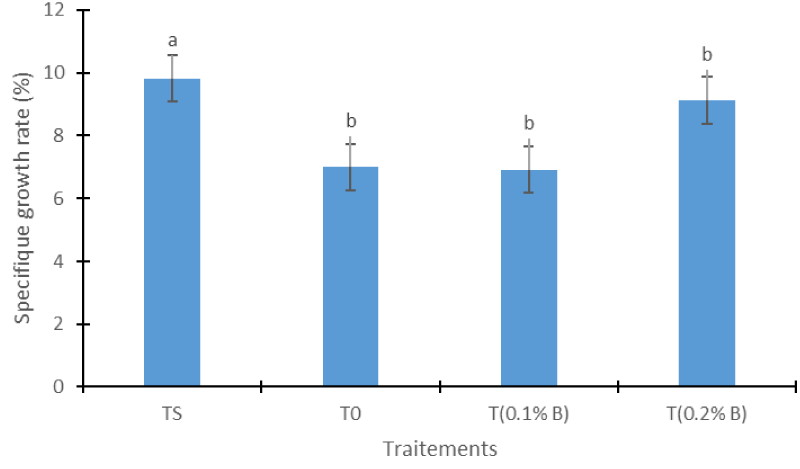
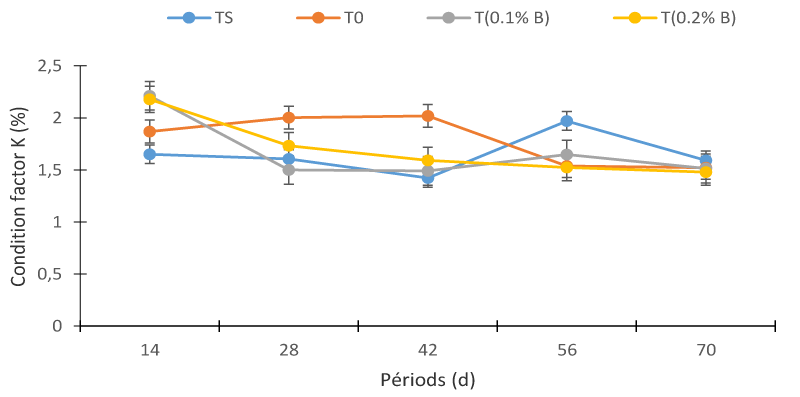

 Save to Mendeley
Save to Mendeley
